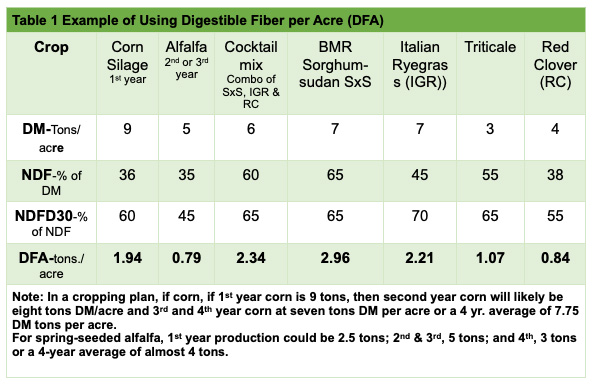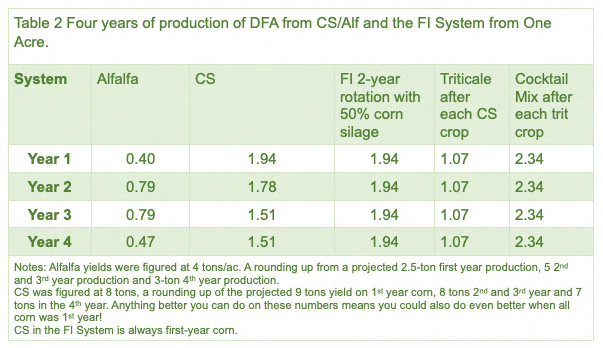This DFA will make you money!
Previously, we talked about increasing yield by using polycultures. This month, we are going to talk about evaluating the yield of any forage crop and a new way of looking at the results. Of course, when a new metric is introduced, you also have a new acronym! We naturally choose one unique to the dairy business so as not to have anyone confused. Our metric—digestible fiber per acre or DFA. Well, maybe we missed on the unique part, however DFA is useful for those attempting to rank forage crops for their usefulness when desiring not only a high-forage diet, but also high production. The measurement is in tons per acre.
To get this number, you must first know the dry matter (DM) yield in tons per acre, either estimated for planning or actual when the crops are in storage. Then obtain the NDF of the forage, and its NDFD30 from the feed test report. To show DFA examples of various crops, see Table 1 below:

Table 1, list crops which are commonly grown, and ones often used in the upper Midwest for Forage Innovations (FI) forage systems. IGR, RC and SxS are components of many cocktail mixes and are each also shown as if they were planted separately. The NDFs and NDFD30s are typical values. The yields could vary with the 1000 variables farmers deal with each year growing crops of which at least 700 involve weather!
The winners on this chart are forages with high NDF which also are highly digestible. For example, BMR corn silage would have a fairly high digestibility, however it has a comparably lower NDF.
Yes, we are only looking at the fiber, and ignoring the grain from the corn silage. We can only say digestible fiber (Energy) is an important part of a diet. Additionally, if we substitute the Cocktail Mix and Triticale for Alfalfa and some of the Corn Silage, we are bringing in, at least in part, compensating portions of Water-Soluble Carbohydrates (WSC or Sugar). Some of these extra sugars are only supplied by grasses.
This chart shows the folly of the many years we assumed all NDF is the same and unfairly discriminated against NDF in ration programming and dry matter intake (DMI) calculations. The discovery from looking at NDFD30 numbers from various forages, is that NDF can be quite different when looking at properly harvested alfalfa, corn silage and grasses. NDF is a composite of three main constituents—cellulose, hemicellulose, and lignin—each with a different digestibility (or indigestibility, in the case of the lignin). Since the relative amounts of these three are not similar, so is the total digestibility of the particular plant’s NDF. Of the three forages, grass NDF is the most digestible.
For the FI system, triticale is a double crop for the field between the corn silage harvest and the June 1 planting of the cocktail mix which in turn is the lead into the next corn silage crop. In the FI system, there is always a cover crop—either the triticale (or cereal rye) or the red clover and possibly the Italian Ryegrass from the cocktail mix. Additionally, the corn silage is reduced to about 50% of the forage and each time corn is grown, it is a first-year crop with triticale or sometimes winter rye following the corn. Following the cocktail mix with corn boosts even further the first-year corn benefit.
To show how DFA plays out, in a rotation, the left side of Table 2 shows a 4-year corn silage/alfalfa rotation each for one acre, and the right side shows a 2-year (repeated) CS/Triticale/Cocktail rotation. The chart shows the four-year total production of DFA for each system. Of course, in this program, some corn is planted 1st year corn, corn-on-corn and, corn-in-corn-on-corn each year. Plus, the alfalfa will have different yields due to its years of its time since sowing.

The right side of the table shows a FI recommended crop plan with comparably typical yields. The difference in the production of digestible fiber is remarkable and virtually necessary when crop planning for a high-forage, high-production diet for your cows! And without using up all your acres to produce it.
Of course, your crop yields could be different due to your farming abilities, weather, and soil. Also, government statistics show alfalfa yields, in the Midwest, have fallen over the last 20 years from 4.3 to 4.0 tons per acre. Attempts to raise alfalfa digestibility also have not helped yields. The advantage in DFA for the FI System will persist under the typical; (normal?) farm conditions.
Are We Only Looking at One Thing?
We recognize that starch and protein are essential considerations in any forage system. However, digestible fiber is the most difficult ration component to import to the farm. It is by far the bulkiest of the macro feed ingredients. While products like gluten, beet pulp and soyhulls can be excellent ration components, they can be expensive, reduce feed efficiency and contribute to nutrient management challenges. This is why we start our forage planning process around high target levels of digestible (NDFD30) and low target levels of undigestible (uNDF240) fiber. This combination facilitates the inception of high-forage, high-production diets!
Crop Planning Comparison
Table 2 does not represent the total picture. Let’s say we want to feed 70% corn silage and 30% alfalfa on a DM basis. Our first step would be to ascertain the acres needed to supply the two forages. Using the values from Table 2, we will compare the two systems for a 1000 cow herd needing 7500 tons of forage DM for the milking herd. Table 3 shows the acres needed and the production in tons DM of the DFA from both the FI system and the CS/Alf rotation (CSA).
In each case, we start with the acres needed for CS. In the CSA system we need 656.25 acres of CS (70% of total forage tons/8 tons per acre). For the alfalfa we need the remainder of the tons 7500-5250=2250 tons of Alf. At 4 tons DM yield per acre, we need 562.5 acres. This produces (1134 + 349) = 1483 tons of DFA. Total acres required was 1218.75.
For the FI system, we need (7500 X 50%) or 3750 tons of CS and 468.75 acres to grow it. Since the rotation is corn followed by triticale, we will have 468.75 acres of triticale (which are the same acres). After the triticale is harvested (in late May or early June) the next crop is 468.75 acres of Cocktail mix. Our total acres used for the forage for this 1000-cow herd is 937.5 acres since we are repeating the rotation each year! The total DM forage production is CS, 3750; Trit, 1406; and Cocktail Mix (CM) 2812.5 for a total of over 7965 tons! But the huge difference is the DFA. Table 4 summarizes the results with minor rounding.

Take Home Lesson
So, what does all this mean? The Forage Innovations forage system provides half again as much DFA and at the same time an extra almost 400 tons of dairy-quality forage on 220 fewer acres. These acres can be, as they say, repurposed for cash crops! A summary of additional benefits include:
- There is always a cover crop.
- Any forage with higher DFA can efficiently produce more milk and less manure.
- A great way to establish no-till farming.
- There is always a place to go with liquid manure. A huge benefit for those forced to do it all in spring and fall when there are other things to do!
- Every corn crop is first-year corn and takes advantage of following sorghum-sudan, with its valuable root exudates providing natural weed and rootworm control. With these advantages, corn company tech and tech fees are less needed (or maybe eliminated).
- Nothing is worse than a high-forage diet when you are short on forage and the forage equipment is in the shed with nothing to do!
- The financial differences can be hundreds of thousands of dollars in having more profitable use of your land and forage which can efficiently produce milk.
- This DFA will never let you down!
If you have any questions, contact Daniel at daniel@forageinnovations.guru or Larry at larry@forageinnovations.guru or 608-516-0101.
